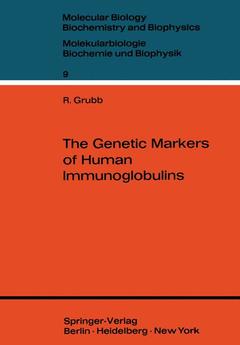The Genetic Markers of Human Immunoglobulins, Softcover reprint of the original 1st ed. 1970 Molecular Biology, Biochemistry and Biophysics Molekularbiologie, Biochemie und Biophysik Series, Vol. 9
Langue : Anglais
Auteur : Grubb Rune E.

It has long been known that every individual has a large number of antibodies of different specificities. Antibodies are gammaglobulins, and protein structure in cells is genetically determined. The extreme multiplicity of structure of the combining sites of antibodies relative to the degree of multiplicity generated by ordinary genetic mechanisms is a fascinating problem of bio-medical importance. The functional heterogeneity of reactions mediated by immunoglobulins-is remarkable, ranging from protection against life-threatening toxins and microbes to the production of laryngeal edema leading to suffocation and death from anaphylaxis. An approach to the understanding of immunoglobulin polymorphism based upon "a knowledge of genetic markers of immunoglobulin structure is not biased by the question of whether or not this polymorphism is related to combining site diversity. Though several recent reviews of the multifacetted problems related to immuno globulins are available, it was decided to publish this survey in the belief that know ledge of the genetic markers of immunoglobulins prqvides such information about immunoglobulin differentiation and its control as cannot be obtained from other sources. Several of the human genetic im~unoglobulin markers are well understood at the molecular level. The Gm system may serv~ as a model for other immuno genetic systems. The published data on the human immunoglobulin factors are widely scattered in journals of different perspectives. There is a need for a systematic presentation of these data and for their critical evaluation.
I Introduction.- Some Basic Introductory Data on Human Immunoglobulins.- II Basic Data Concerning Genetic Human Immunoglobulin Markers.- Techniques.- The Particles Carrying Immunoglobulins and the Mode of Attachment of the Immunoglobulin.- The Immunoglobulin Attached to the Surface of the Particle.- Nomenclature.- Introductory Survey of Main Genetic Ig Factors.- III Interpretation of Immunological Concepts and of Notational Terms in Structural Concepts.- Chemical Correlate of Descriptive Terms.- Amino Acid or Carbohydrate Variation?.- Relation to Chains.- Correlation between Subclasses of IgG and Particular Gm Factors.- Gm and Inv Factors Correlated with Amino Acid Substitutions.- Gm and Inv Factors in Relation to Quaternary Protein Structure and as Examples of “Hybrid” Antigens.- Some Pitfalls in the Interpretation of Statistics of Immunologic Findings in Terms of Chemical Structure, as Elucidated by Studies of the Gm System. Degree of Complexity.- IV The Formal Genetics of the Gm and Inv Systems.- Lack of Evidence for Excessive Mutability within the Gm and Inv Systems.- Linkage Relations between the Gm System and Other Polymorphic Systems, in Particular Inv.- Associations between Particular Gm Factors Due to the Presence of Determinants on the Same H-Polypeptide Chain. The Distribution of Gm Factors among the IgG Molecules within a Given Individual.- Associations between Particular Gm Factors Observed in Segregation Studies in Families.- The Gm Chromosome Segment as a Compound of Several Loci, Each Related to an IgG Subclass.- The Question of Crossing Over between IgG Loci.- “Gm-” Alleles and Their Interpretation.- Evaluation.- The Formal Genetics of the Inv System.- V Human Anti-Human-Gammaglobulins, Their Specificity and Function. Genetic Ig Factors and Tolerance.- Categories of Human Anti-Human-Ig.- The Concept of Allosteric Change as Applied to Immunologic Reactions, in Particular to the Anti-Antibody of Milgrom Type.- The Appearance of Anti-Gm’s in Early Extrauterine Life. Genetic Ig Factors and Tolerance.- Physiological and Pathophysiological Roles of Anti-Gamma-globulins.- Anti-Ig’s as Regulators of Production of Particular Ig Types.- The Genetic Ig Factors and Isoimmunization. The Anti-Globulins in Relation to Transfusion Reactions.- Anti-Human-Gammaglobulins in Transplantation.- Human Anti-Human-Gammaglobulins in Relation to Diseases, Particularly to Rheumatoid Arthritis.- VI Immunoglobulin Polymorphism as an Example of Molecular Differentiation in Macroorganisms. Mutual Allelic Exclusion.- Phylogeny of Immunoglobulin Polymorphism.- Variation in Ig Polymorphism with Ethnic Group.- Ontogeny of Immunoglobulin Polymorphism.- The Potentiality for Immunoglobulin Production in the Human Foetus.- The Development of Genetic Immunoglobulin Factors During Extrauterine Life.- Ig Genetic Factors During Antigenic Stimulation.- Ig Genetic Factors in Various Body Compartments.- Relation of Ig Genetic Factors of Mother and Child at Birth.- Regional Differentiation within the Immunoglobulin-Producing Cell Population. Allelic Exclusion.- Application in Forensic Medicine.- VII Selection and Control of Immunoglobulin Structure.- Levels of Genetic Control of the Immune Response.- Genetics of Antibody Deficiency and Dysgammaglobulinemia Syndromes.- Regulation of Ig Structure. Levels of Control.- Control at the Level of Gene to Polypeptide. Mendelism of Ig Genes.- The Number of Loci for Ig Structural Genes in Man.- The Genetic Human Ig Markers and the Relationship between Constituent Parts of thelg Chains.- Locus Selection in Ig Production.- Models for Allelic Exclusion in Ig Production.- Allelic Exclusion Experimentally Induced in Animals by Means of Anti-Allotype Antibody.- Models from Lower Organisms.- Some Consequences of Allelic Exclusion and Locus Choice.- The Non-Random Character of Partner Chain Selection.- Clonal Regulation in the Macroorganism.- Ig Structure Related to Antibody Properties Other than Antigen-Binding. Evolutionary Aspects.- Appendix Compilation of Data Concerning Genetic Factors of Human Immunoglobulins.- Gm(l).- Gm(2).- Gm(3).- Gm(4).- Gm(5).- Gm(6).- Gm(7).- Gm(8).- Gm(9).- Gm(10).- Gm(ll).- Gm(12).- Gm(13).- Gm(14).- Gm(15).- Gm(16).- Gm(17).- Gm(18).- Gm(19).- Gm(20).- Gm(21).- Gm(22).- Gm(23).- Gm(m).- Inv(l).- Inv(2).- Inv(3).- Isf(l).- Am.- Miscellaneous Factors, Hitherto not Properly Defined, but Possibly Related to the Gm System.- References.
Date de parution : 01-1970
Date de parution : 03-2012
Ouvrage de 154 p.
17x24.4 cm
Disponible chez l'éditeur (délai d'approvisionnement : 15 jours).
Prix indicatif 105,49 €
Ajouter au panierThèmes de The Genetic Markers of Human Immunoglobulins :
Mots-clés :
© 2024 LAVOISIER S.A.S.



